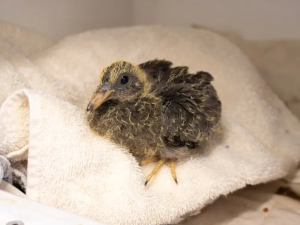Column: Know what to do if you find a baby bird or other wildlife in distress

An orphaned band-tailed pigeon is currently receiving care at Pasadena Humane’s Sandra J. Goodspeed Wildlife Center. The pigeon will be rehabilitated and released when it is old enough to survive on its own in the wild.
My husband, Pierce, and I have finally faced the fact that we are empty nesters.
Our son is 23 and is recently engaged to be married. He has lined up a great paid internship in New York City this summer, which will hopefully lead to a job when he graduates from college next spring.
After years of focusing on raising and launching our only child, we realize we are now at a stage of life where we can re-focus on ourselves.
While Pierce and I are spending a little more time enjoying each other’s company and pursuing our hobbies, hundreds of local bird species are busy working to set up temporary housing around town. Why? Well, it’s nesting season.
Nesting season is the time of year when birds are laying eggs and hatching chicks. For many bird species in California, this typically lasts from February through August.
Birds build nests so they have a place to lay their eggs and raise their young. Nests keep young birds warm while also providing protection from predators and inclement weather.
Many of our local birds are well adapted to living in urban environments and will nest in backyard trees, bushes and even on the ground.
Different species have different types of nests, but, in general, birds make nests from sticks, twigs, leaves, grasses and mud. They also use fur from our pets and wildlife. Hummingbirds even use spiderwebs to build their nests.
It’s best to avoid trimming your trees during nesting season. When pruning and removing vegetation, nests might be crushed or destroyed, or the parents may abandon active nests due to the threat of close human proximity and disturbance to their habitat.
Instead, schedule your tree trimming from fall to late winter. Not only will this benefit local birds, but pruning during colder months is better for most trees.
Before you start trimming, consider hiring a wildlife trained arborist, certified through the International Society of Arboriculture. Also, be sure that you and your arborist are aware of the federal, state and local laws that protect nesting birds from being disturbed.
Interfering with a nest may be in violation of the law. The California Fish and Wildlife code contains several sections that detail protections for birds, including unlawful take, possession or needless destruction of a bird’s nest or eggs.
Many nesting birds are also protected under the federal Migratory Bird Treaty and Endangered Species acts.
Also, it’s not just birds that nest in trees. Some mammals do, too! Tree-nesting fox squirrels’ orphaned and injured young make up a large percentage of the wild animals we care for at Pasadena Humane’s Wildlife Center.
Plus, some bats nest in trees (yes, bats are mammals), such as the local hoary bat.
If you’ve found a nest during tree trimming and need assistance, we are here to help. Text photos to the Pasadena Humane Wildlife Helpline at 626-344-1129.
We can identify the type of nest and recommend appropriate next steps. In most cases, we will recommend waiting to finish the job until the nest is no longer active.
We’ve already seen a handful of orphaned and injured baby birds come into our care this year — harbingers of what we expect to be a busy baby wildlife season.
Our current patients include two band-tailed pigeon fledglings that came in due to injuries last month and needed to be hand-fed multiple times a day.
They have graduated to our outdoor aviary, where they are learning to fly, forage for food, and “wild up.”
The plan is for them to be released back into the wild later this month.
To learn more about what to do if you find a baby wild animal, pasadenahumane.org/wildlife and pasadenahumane.org/services/wildlife/finding-baby-wildlife
Dia DuVernet is president and CEO of Pasadena Humane.
This blog post originally appeared as a column in the Pasadena Star-News on March 22, 2024.


